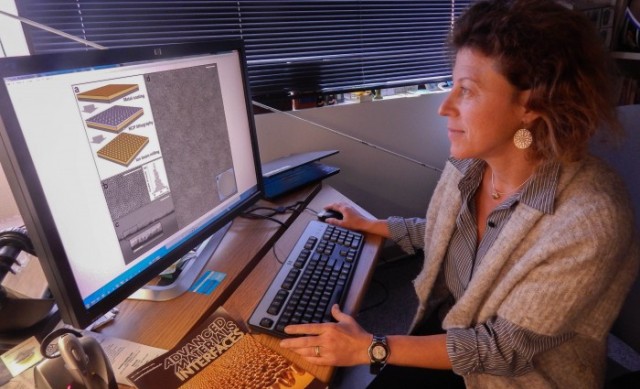 Tiziana Bond, an LLNL engineer and member of the joint research team, helped developed a cost-effective and more efficient way to manufacture nanoporous metals, from nanoscale to macroscale, which is visible to the naked eye. Photo by Julie Russell/LLNL.
Tiziana Bond, an LLNL engineer and member of the joint research team, helped developed a cost-effective and more efficient way to manufacture nanoporous metals, from nanoscale to macroscale, which is visible to the naked eye. Photo by Julie Russell/LLNL.
Researchers from the Swiss Federal Institute of Technology (ETH) and Lawrence Livermore National Laboratory (LLNL) have presented a new technique to inexpensively and efficiently fabricate nanoporous metals from nanoscale to macroscale.
Nanoporous metals are foam-like substances consisting of an air vacuum to a certain extent and a large surface area for efficient transfer of electrons. These metals facilitate more sites for analyte adsorption.
The researchers coated a four-inch silicon wafer with metals such as aluminum, silver and gold. They added a mixture consisting of two polymers to the metal substrate through a process called diblock copolymer lithography (BCP).
Following this, an array of holes were etched into the substrate through a process called anisotropic ion beam milling (IBM), forming the nanoporous metal.
The roughness of the nanoporous metal was continuously monitored during fabrication to ensure porosity was achieved. One of the team members said that 92% pore coverage with 99% uniformity was achieved over a 4-in silicon wafer.
The real breakthrough is that we created a new technique to manufacture nanoporous metals that is cheap and can be done over many scales avoiding the lift-off technique to remove metals, with real-time quality control.
These metals open the application space to areas such as energy harvesting, sensing and electrochemical studies
Tiziana Bond - LLNL Engineer and member of the research team
In addition, the team established a metric corresponding to a parametrized correlation between the metal surface roughness and BCP pore coverage. The fabrication process should then be ceased to avoid uneven porosity, thereby reducing cost and processing times.
This new technique is a substitute for the traditional lift-off technique which involves uneven peeling of metal layer at the nanoscale, by patterning target materials on the substrate with a sacrificial material.
The nanoporous metals may be used in the development of new metamaterials for radiation-based filtering. They also enhance light transmission via the tunneling of surface plasmons, a well-known concept used in refractive-index-based sensing, all-optical switching, plasmonic lithography and light-emitting devices.